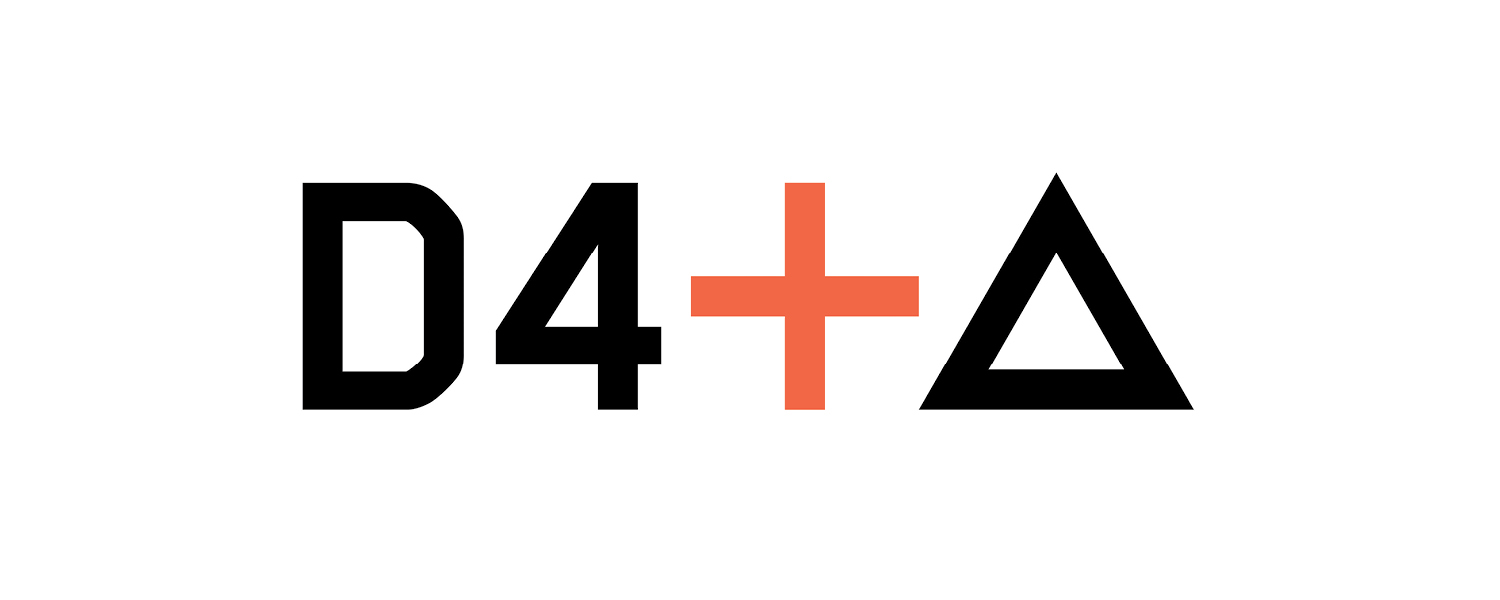Date Posted: 01.24.2023
The American Institute of Architects (AIA) recently recognized Mithun with the 2023 AIA Architecture Firm Award. This national accolade celebrates exemplary design and practice, and is the highest honor the AIA bestows on an architecture firm.
We are thrilled to receive this significant recognition. Mithun’s success is built upon the values and vision of multiple generations of the firm, which has grown to encompass 180 team members in Seattle, San Francisco and Los Angeles. Our work throughout the West Coast and across the nation demonstrates that integrated design—including architecture, landscape architecture, interior design, urban design and planning—can be a driving force in creating a sustainable and humane future for all.
“This accomplishment is a testament to our incredible project partners—clients, contractors, engineers, collaborating designers, researchers and community members,” said Mithun president David W. Goldberg FAIA. “Together, we’re working to make a positive impact every day for the communities we serve and the health of our planet.”
“Architectural excellence is achieved when an inspiring building is designed beyond its property lines to serve the clients’ needs, the values of its community, and the vital needs of our planet, our only home,” wrote William Leddy FAIA, principal at Leddy Maytum Stacy Architects, winner of the 2017 AIA Architecture Firm Award, in a letter of support. “I can think of no architecture firm that better exemplifies this vision of a values-based, mission‐driven practice than Mithun.”
We invite you to explore a brief history and key focus areas of our practice:
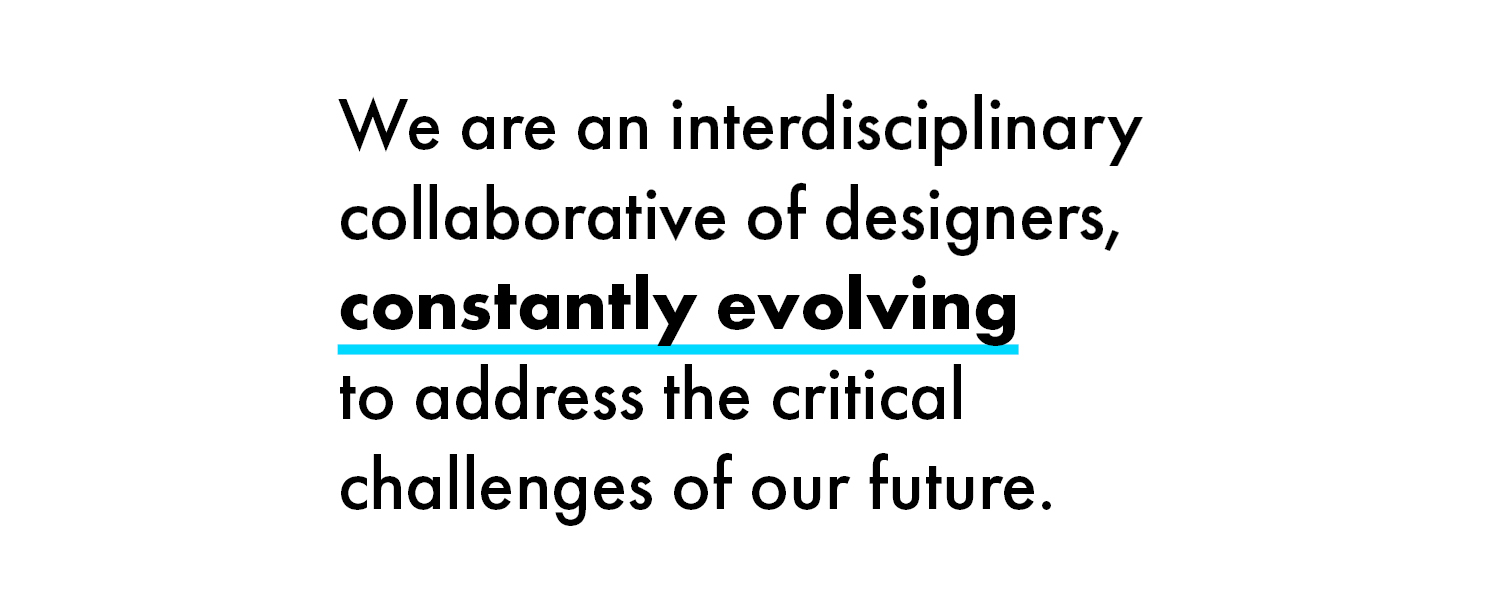
A SHARED MISSION WITH DEEP ROOTS
Mithun is an integrated design firm dedicated to creating positive change in people’s lives. For us, design is a holistic, interdisciplinary pursuit that places users and community, not objects and agendas, at the center of decision-making. This integrated approach honors the identity of places—culture, history and ecology—with a reverence for the characteristics that make each unique.
Omer Mithun, a beloved professor at the University of Washington, founded the practice in 1949, and grew the firm with award-winning, mid-century modernist work throughout the Pacific Northwest. Omer had a curious spirit, which led to many early explorations in passive solar design, and his passion in education created a strong culture of mentorship and empowerment for the firm. While Omer passed away in the early 1980s, his legacy and ethos live on not just in the firm name, but in our steadfast commitment to education, environment, community and civic engagement.
In the 1990s, the practice took a strong leadership role in the emerging sustainable design movement. With cutting-edge project work, investments in research and development, and a curious and innovative spirit, Mithun continues to be recognized as one of the seminal national thought leaders in this area.
In order to expand the positive impact of our work beyond the building to the district, city and ecosystem scales, the firm committed to the growth of landscape architecture and urban design and planning teams, which, alongside architecture and interior design, have become fundamental to our integrated design process. Additionally, our focus on sustainable design has naturally grown into issues of human health, equity and design for resilience, broadening our project typologies and the diversity of our design professionals.
As the firm’s reputation continued to grow, our work quickly expanded up and down the West Coast and to a national scale with significant sustainable design commissions across the country. Today, with offices in Seattle, San Francisco and Los Angeles, our “one studio, three doors” spirit is held by more than 180 professionals, each of whom is inspired and empowered to realize our mission of “Design for Positive Change.”
Even though the practice is committed to tackling big issues, “Mithunees” are known for being great listeners, having a tremendous sense of optimism, and balancing serious hard work with good spirits, a commitment to family, community and time well spent in nature. While we take our work very seriously, we try not to take ourselves too seriously. This sense of character and collaboration is foundational to our design process and professional leadership.
While the firm’s ethos and values are deeply rooted in our history, we are committed to constantly evolving our practice to address the critical challenges of our time. This evolution is core to our firm culture, and we are looking forward to where it will lead us as our fifth and sixth generations of design leaders chart our future ahead.
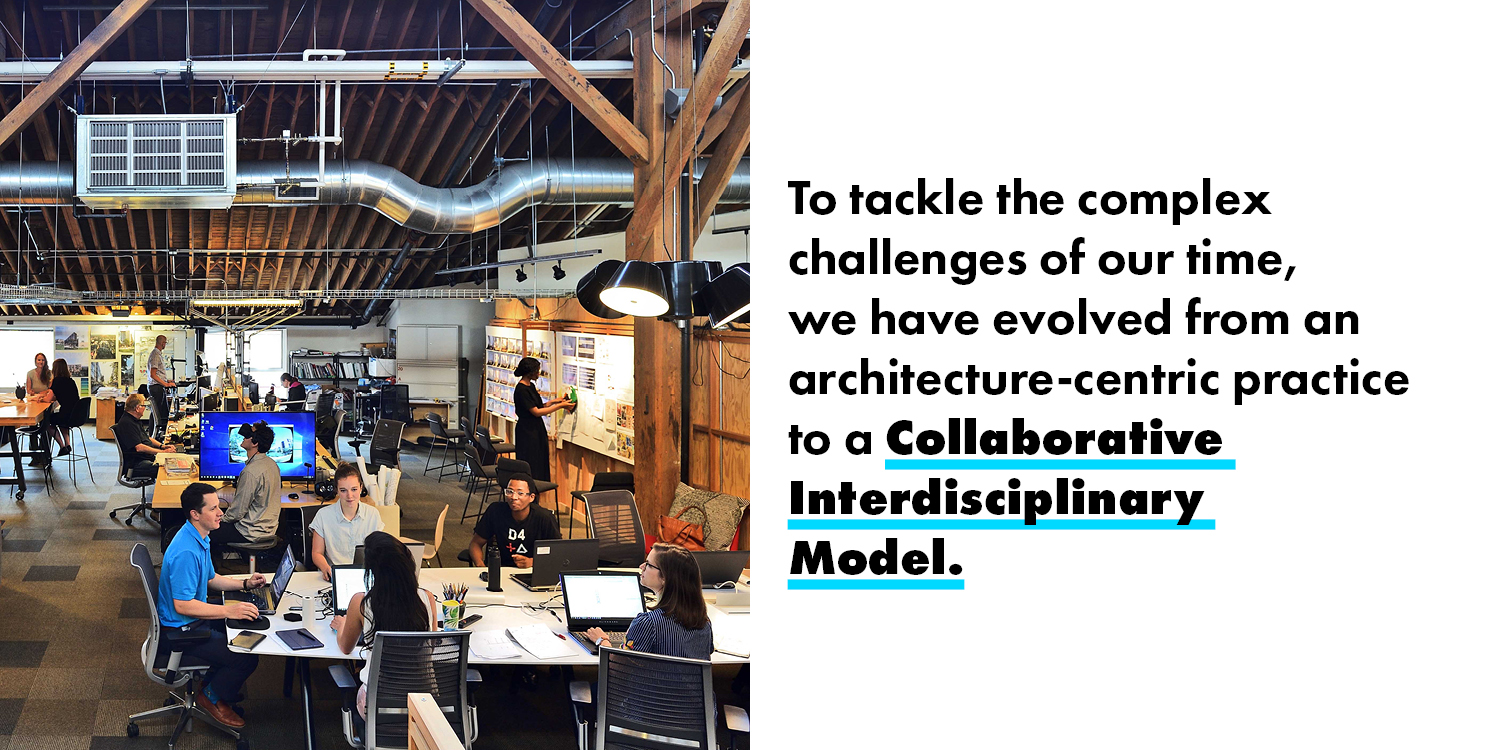
COLLABORATIVE INTERDISCIPLINARY MODEL
The 20th century was a time of unprecedented technical advancements resulting from deep specialization in the fields of science, engineering and design. But with this “progress,” global communities have found themselves facing a long list of environmental issues that we still face today, including water quality, exposure to toxins and a rapidly warming climate. Mithun believes that progress on these issues requires a new model of architectural practice, one that breaks down the silos of expertise that have traditionally been part of the design process. We believe that this new paradigm must be led by a new model of architect, dispelling the myth of the “all-knowing genius designer” and embracing the model of architect as inspirational collaborator, listener and design leader.
“Integrated perspectives are fundamental to Mithun’s design process and culture, and the overlay of thinking among disciplines continues to unlock innovations in our work,” said partner Brendan Connolly. “This kind of holistic thinking through research and project work continues to drive high-performing design solutions that serve our clients and communities.”
Mithun has embraced this collaborative, silo-breaking imperative throughout all aspects of the firm. Unlike many mid-sized firms, we have resisted the creation of internal design studios, instead structuring the practice for the sharing of ideas and expertise broadly across the practice. Interdisciplinary teams sit together around their projects, rather than being grouped in teams based on expertise. Similarly, we treat our three West Coast locations as “one-office with three doors,” an important key to our shared firm culture and values.
Working in a deeply integrated fashion, with all design disciplines “at the table” from day one, has resulted in a body of work that is authentically rooted in place and community, rather than from the vision of a singular designer.
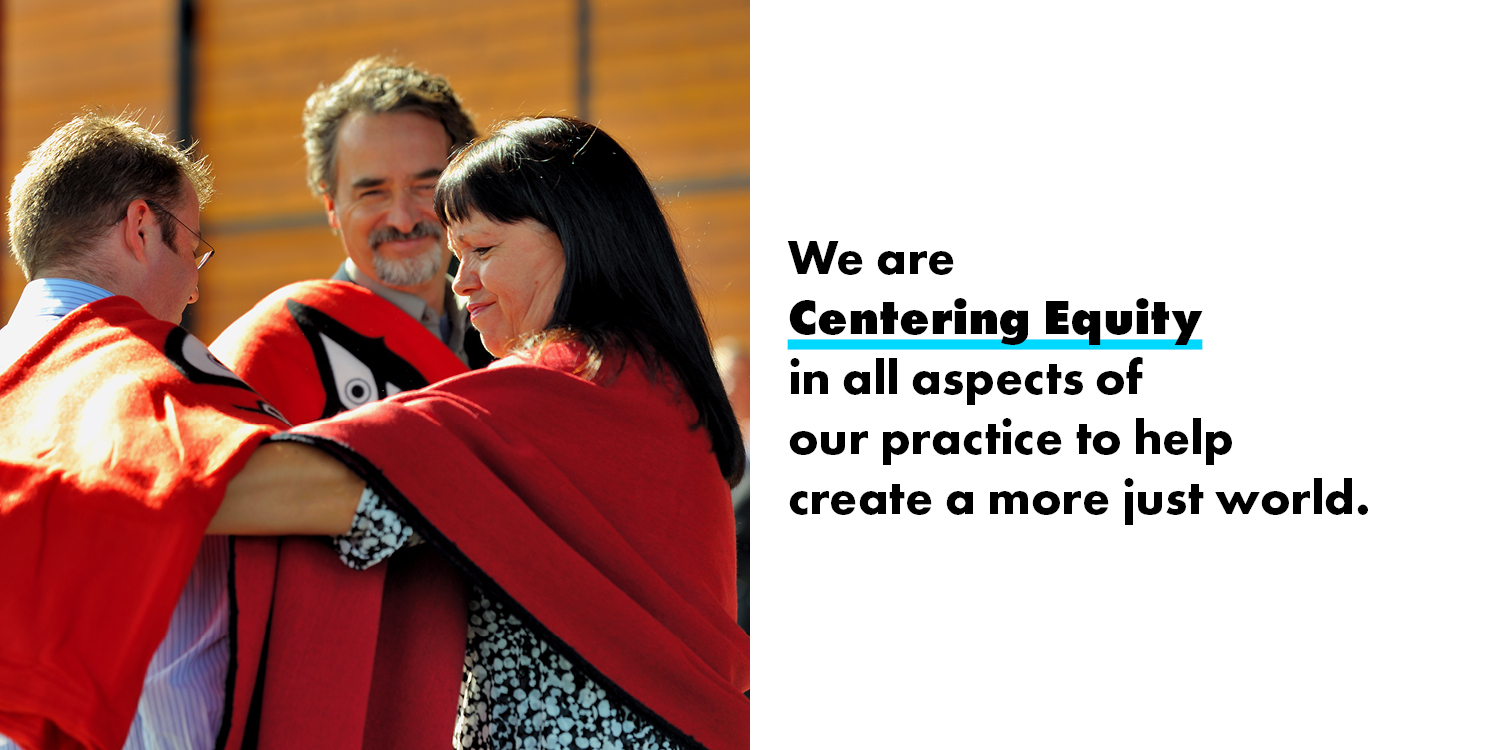
CENTERING EQUITY
As a currently majority-white led firm, we recognize that we have benefited from the power and choice afforded us by centuries of structural racism. We are asking ourselves: How can we use that power and choice to combat racism, bias and discrimination in all its forms, including discrimination based on gender identity and physical ability? What are the operational and structural changes we need to make in our own organization? How can we serve as allies to BIPOC and other non-majority communities in the places where we live, where we work and where we practice? And how can we best use our skills as designers and integrated thinkers for healing and empowerment?
These are not new questions for us, but we commit to always digging deeper, and to concrete actions to specifically address the diversity of our team, the impact of our integrated design work, ongoing education and training, and strategic support of our community partners. Open dialogue is crucial if we are to evolve as a practice and as a community. We welcome the discomfort of continually uncovering our own blind spots and opportunities for growth.
“We as designers have the responsibility and skill to show how cities can be beautiful, highly integrated and choice-rich—how they can make sustainable living convenient no matter your income, near parks, near transit, near all the resources needed to live a healthy, stable life,” explains partner Anne Torney. “We are all making pieces of a social ecosystem, and the point is not only the structures we create but the life they support. The well-being and potential of individuals, families and communities is WHY we do what we do.”
Affordable housing, work with tribal communities and working with underserved communities on long-term health and resilience planning have become a significant focus of our practice. As part of our commitment to using our skills as designers and integrated thinkers to support social and racial equity, Mithun also provides pro bono design services to under-served communities by partnering with local grassroots organizations. In the last 15 years, we have donated more than 10,000 hours of pro bono design to more than 70 community-serving projects—about 1% of our net revenues on an annual basis.
We pledge to be transparent about our progress. We are continually inspired by the work of our communities, clients and collaborators, and hope in turn to inspire others, together creating a durably just world. There is so much important work still ahead.
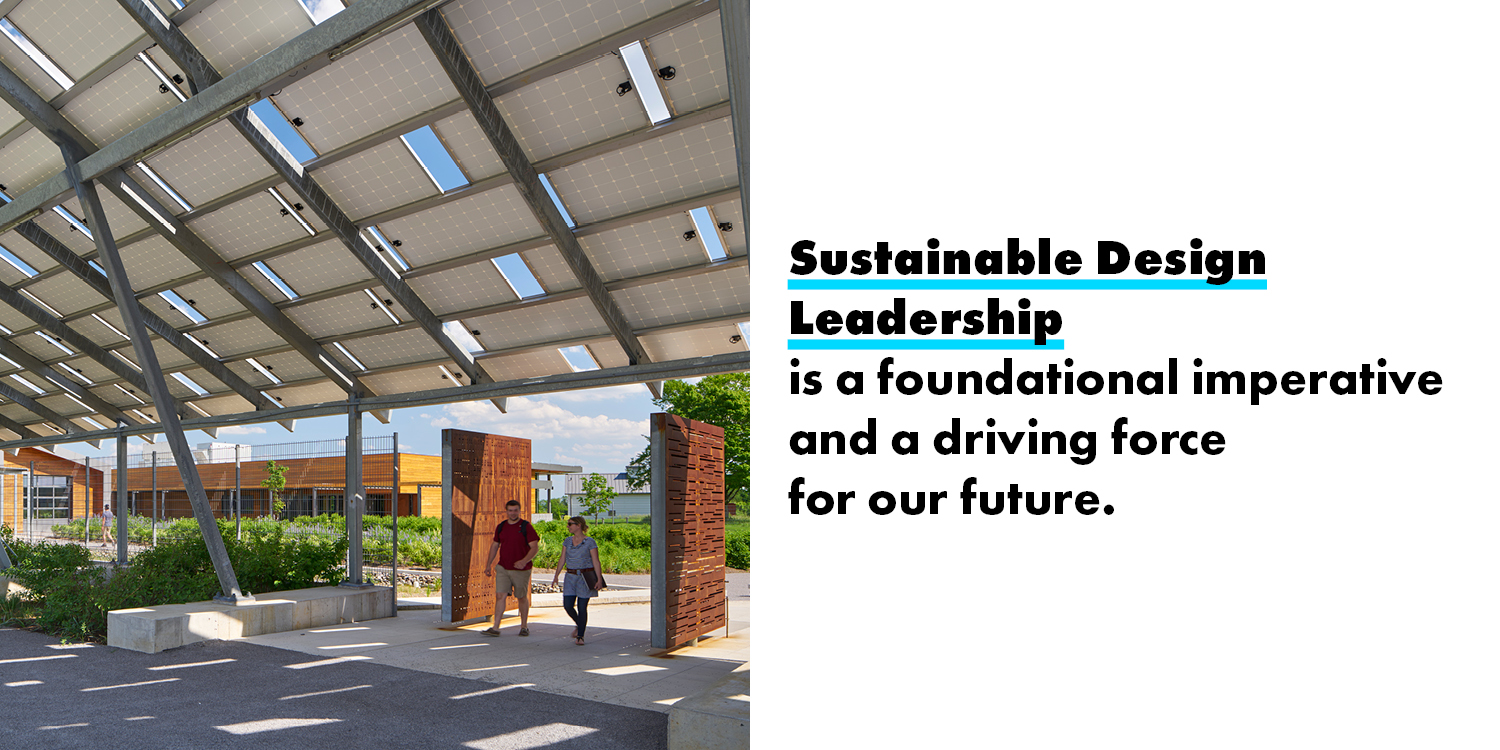
SUSTAINABLE DESIGN LEADERSHIP
Sustainable design has been a core part of the firm’s DNA since the 1950s with the design of nationally recognized commercial, civic and residential buildings incorporating passive solar heating and cooling strategies. In the mid-1990s, with the design of REI Flagship Stores in Seattle and Denver, followed by the IslandWood Environmental Learning Center, Mithun began an active leadership role in growing the modern sustainable design movement that continues to this day.
The firm’s accomplishments include seven AIA COTE design awards, ranging from a net-zero energy educational treehouse to a visionary urban design plan for more than 1,000,000sf of development. We have been sponsors and advocates for numerous sustainability initiatives, and have given more than 500 presentations on sustainable design for audiences nationally and internationally. Mithun firm leaders helped develop the LEED Neighborhood Development (ND) program, Sustainable Sites Initiative (SITES), and are collaborating with USGBC and the University of Virginia on incorporating design for health into the current LEED rating system.
The firm has committed to carbon neutral operations since 2004, was an early signatory to the 2030 Challenge, and recently completed a Living Building renovation to our headquarters on the Seattle waterfront.
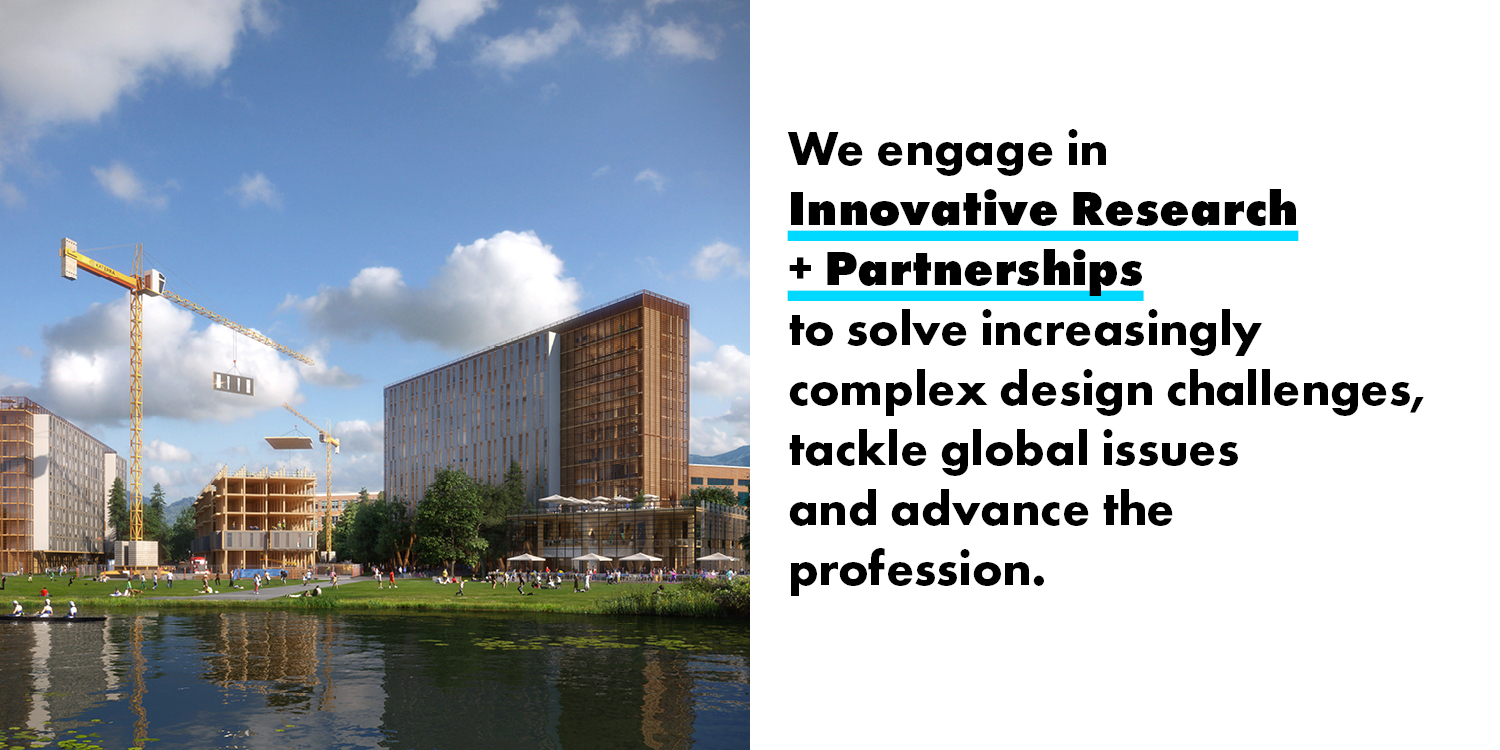
INNOVATION, RESEARCH + PARTNERSHIPS
Advancing sustainability and equity in the design of built environments requires moving quickly beyond the processes and approaches that have remained virtually unchanged for many generations. Changing the status quo in such a large industry requires both innate curiosity and steadfast resolve.
For decades, inquisitive designers at Mithun have been stepping beyond the bounds of traditional project scopes to conduct research around wide-ranging topics that impact design, practice and society, while creating new knowledge and bridging industry gaps. Our open-source approach to research and knowledge ensures that the results become tools for widespread use and positive impact.
Early research ventures were typically tied to a specific project to help answer a key project imperative, such as sourcing sustainable materials, protecting ecosystem health, and novel passive heating and cooling strategies. The firm has also self-funded research projects such as buildcarbonceutral.org, the first free, public web-based embodied carbon calculator, designed by Mithun in collaboration with the Lady Bird Johnson Wildflower Center in 2007, and still in use today.
This curiosity continued to be integral to the firm’s culture, expanding to commissioned and non-commissioned research projects like The Resource Guide for Sustainable Development in an Urban Environment, using Seattle’s burgeoning South Lake Union as a template for advancing sustainability in a market economy; Lloyd Crossing Sustainable Urban Design Plan, a neighborhood level strategy that stimulated the EcoDistricts movement; and the Mariposa Healthy Living Toolkit, a revolutionary systemized guide to include health as fundamental to planning and design.
To accelerate design research into key global issues, in 2008 the firm established the Mithun/Russell Family Foundation Endowed Professorship in Sustainability at the University of Washington College of Built Environments, with Stephen Kieran and James Timberlake as the inaugural Endowed Professors. Kate Simonen is the current Endowed Professor and is leading the groundbreaking Carbon Leadership Forum.
Building on our legacy and history of research and development, in 2016, R+D efforts were formalized within the practice to further the mission of the firm. Mithun R+D is grounded in the firm mission—Design for Positive Change—seeking to advance design knowledge and its application. Through internal project research, external partnerships, and intellectual research pursuits, Mithun R+D transforms projects and design with meaningful inquiry and exploration. Since 2016, we have funded over $1,000,000 and 10,000 hours of R+D, with participation from more than 100 Mithun staff.
